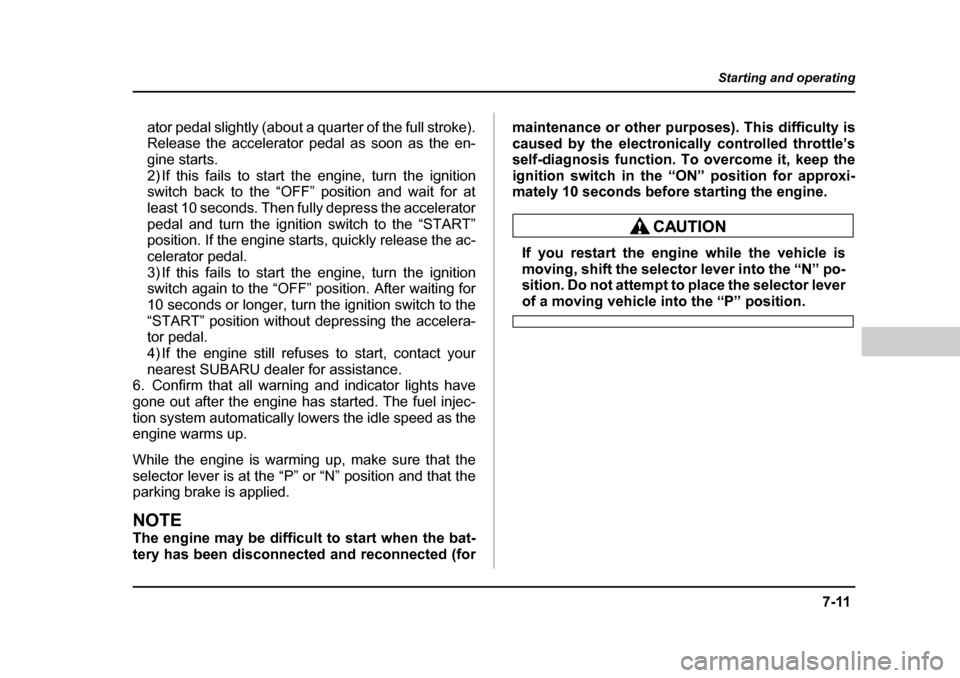Page 268 of 477

7-11
Starting and operating
– CONTINUED –
ator pedal slightly (about a quarter of the full stroke).
Release the accelerator pedal as soon as the en-
gine starts.
2) If this fails to start the engine, turn the ignition
switch back to the “OFF” position and wait for at
least 10 seconds. Then fully depress the accelerator
pedal and turn the ignition switch to the “START”
position. If the engine starts, quickly release the ac-
celerator pedal.
3) If this fails to start the engine, turn the ignition
switch again to the “OFF” position. After waiting for
10 seconds or longer, turn the ignition switch to the
“START” position without depressing the accelera-
tor pedal.
4) If the engine still refuses to start, contact your
nearest SUBARU dealer for assistance.
6. Confirm that all warning and indicator lights have
gone out after the engine has started. The fuel injec-
tion system automatically lowers the idle speed as the
engine warms up.
While the engine is warming up, make sure that the
selector lever is at the “P” or “N” position and that the
parking brake is applied.
NOTE
The engine may be difficult to start when the bat-
tery has been disconnected and reconnected (for maintenance or other purposes). This difficulty is
caused by the electronically controlled throttle’s
self-diagnosis function. To overcome it, keep the
ignition switch in the “ON” position for approxi-
mately 10 seconds before starting the engine.
If you restart the engine while the vehicle is
moving, shift the selector lever into the “N” po-
sition. Do not attempt to place the selector lever
of a moving vehicle into the “P” position.
Page 302 of 477

8-1
8
Driving tips
New vehicle break-in driving – the first 1,000 miles (1,600 km) .............................. 8-2
Fuel economy hints ...................................... 8-2
Engine exhaust gas (Carbon monoxide) ... 8-3
Catalytic converter ....................................... 8-4
Periodic inspections .................................... 8-5
Driving in foreign countries ......................... 8-6
Driving tips for AWD vehicles ..................... 8-6
Off road driving ............................................ 8-8
Winter driving ............................................... 8-10 Operation during cold weather ........................ 8-10
Driving on snowy and icy roads ...................... 8-11
Corrosion protection ........................................ 8-12
Snow tires .......................................................... 8-13
Tire chains ......................................................... 8-13
Rocking the vehicle .......................................... 8-14
Loading your vehicle ................................... 8-14 Vehicle capacity weight .................................... 8-16
GVWR and GAWR (Gross Vehicle Weight Rating and Gross Axle Weight Rating) ........ 8-16
Roof rail and crossbar (if equipped) ............... 8-17
Trailer hitch (if equipped) ............................ 8-22 Connecting a trailer .......................................... 8-23
When you do not tow a trailer .......................... 8-25
Trailer towing ................................................ 8-25 Warranties and maintenance ........................... 8-25
Maximum load limits ......................................... 8-26
Trailer hitches ................................................... 8-30
Connecting a trailer .......................................... 8-31 Trailer towing tips ............................................. 8-33
Page 306 of 477
8-5
Driving tips
– CONTINUED –
running rough (misfiring, backfiring or incomplete
combustion), have your vehicle checked and repaired
by an authorized SUBARU dealer. �yDo not apply undercoating or rust prevention treat-
ment to the heat shield of catalytic converter and the
exhaust system.
�y Avoid fire hazards. Do not drive or park the
vehicle anywhere near flammable materials
(e.g. grass, paper, rags or leaves), because the
catalytic converter operates at very high tem-
peratures. �y Keep everyone and flammable materials
away from the exhaust pipe while the engine is
running. The exhaust gas is very hot.
Periodic inspections
To keep your vehicle in the best condition at all times,
always have the recommended maintenance services
listed in the maintenance schedule in the “Warranty
and Maintenance Booklet” performed at the specified
time or mileage intervals.
Page 310 of 477

8-9
Driving tips
– CONTINUED –
could create a fire hazard. �yAfter driving through tall grass, mud, rocks, sand,
rivers, etc., check that there is no grass, bush, paper,
rags, stones, sand, etc. adhering to or trapped on the
underbody. Clear off any such matter from the under-
body. If the vehicle is used with these materials
trapped or adhering to the underbody, a mechanical
breakdown or fire could occur.�y Secure all cargo carried inside the vehicle and make
certain that it is not piled higher than the seatbacks.
During sudden stops or jolts, unsecured cargo could
be thrown around in the vehicle and cause injury. Do
not pile heavy loads on the roof. Those loads raise the
vehicle’s center of gravity and make it more prone to
tip over. �y If you must rock the vehicle to free it from sand or
mud, depress the accelerator pedal slightly and move
the selector lever back and forth between “D” and “R”
repeatedly. Do not race the engine. For the best pos-
sible traction, avoid spinning the wheels when trying to
free the vehicle.
When the road surface is extremely slippery, you can
obtain better traction by starting the vehicle with the
transmission in 2nd than 1st (both for MT and AT). �y Never equip your vehicle with tires larger than those
specified in this manual. �y Frequent driving of an AWD vehicle under hard-driv- ing conditions such as rough roads or off roads will ne-
cessitate more frequent replacement of engine oil,
brake fluid and transmission oil than that specified in
the maintenance schedule described in the “Warranty
and Maintenance Booklet”.
Remember that damage done to your SUBARU while
operating it off-road and not using common sense pre-
cautions such as those listed above is not eligible forwarranty coverage. �y
Wash the vehicle’s underbody after off-road driving.
Suspension components are particularly prone to dirt
buildup, so they need to be washed thoroughly.
�y Always maintain a safe driving speed accord-
ing to the road and weather conditions in order
to avoid having an accident on a sharp turn,
during sudden braking or under other similar
conditions.�y Always use the utmost care in driving – over-
confidence because you are driving an All-
Wheel Drive vehicle could easily lead to a seri-
ous accident.
Page 326 of 477

8-25
Driving tips
– CONTINUED –
NOTE
Always disconnect the trailer wire harness before
launching or retrieving a watercraft. �„When you do not tow a trailer
�y Remove the ball mount from the hitch receiver tube
and insert the receiver cover onto the hitch receiver tube. �y Place the dust cap over the fou-pin connector of the
hitch wire harness to protect against possible damage. �y Occasionally lubricate terminals of the four-pin con-
nector using terminal grease.Trailer towing
Your vehicle is designed and intended to be used pri-
marily as a passenger-carrying vehicle. Towing a trail-
er puts additional loads on your vehicle’s engine, driv-
etrain, brakes, tires and suspension and has an ad-
verse effect on fuel economy.
If you do decide to tow a trailer, your safety and satis-
faction depend upon proper use of correct equipment
and cautious operation of your vehicle. Seek the ad-
vice of your SUBARU dealer to assist you in purchas-
ing a hitch and other necessary towing equipment ap-
propriate for your vehicle. In addition, be sure to follow
the instructions on correct installation and use provid-
ed by the trailer and other towing equipment manufac- turers.
SUBARU assumes no responsibility for injuries or ve-
hicle damage that result from trailer towing equipment,
or from any errors or omissions in the instructions ac-
companying such equipment or for your failure to fol-
low the proper instructions. �„ Warranties and maintenance
SUBARU warranties do not apply to vehicle damage
or malfunction caused by trailer towing. If you use your
vehicle to tow a trailer, more frequent maintenance will
be required due to the additional load. (Refer to “Main-
Page 327 of 477
8-26
Driving tips
tenance schedule under severe driving conditions” in
the “Warranty and Maintenance Booklet”.)
Under no circumstances should a trailer be towed with
a new vehicle or a vehicle with any new powertrain
component (engine, transmission, differential, wheel
bearings, etc.) for the first 1,000 miles (1,600 km) of
driving. �„
Maximum load limits
Never exceed the maximum load limits ex-
plained below. Exceeding the maximum load
limits could cause personal injury and/or vehi-
cle damage.
�yAdequate size trailer brakes are required
when the trailer and its cargo exceed 1,000 lbs
(453 kg) total weight. �y Before towing a trailer, check the trailer total
weight, GVW, GAWs and tongue load. Make
sure the load and its distribution in your vehicle
and trailer are acceptable.
�T Total trailer weight
Total trailer weight
The total trailer weight (trailer weight plus its cargo
load) must never exceed the maximum weight shown
below.
HS8016AA
Page 338 of 477

9-1
9
In case of emergency
If you park your vehicle in case of an emergency ............................................ 9-2
Flat tires ......................................................... 9-3 Changing a flat tire ........................................... 9-3
Jump starting ................................................ 9-9 How to jump start ............................................. 9-10
Engine overheating ....................................... 9-12 If steam is coming from the engine compartment .................................................. 9-12
If no steam is coming from the engine compartment .................................................. 9-12
Towing ........................................................... 9-13 Towing and tie-down hooks ............................ 9-13
Using a flat-bed truck ....................................... 9-15
Towing with all wheels on the ground ............ 9-15
Rear gate – if the rear gate cannot be unlocked ..................................................... 9-17
Moonroof – if the moonroof cannot be closed ......................................................... 9-18
Maintenance tools ......................................... 9-19 Jack and jack handle ........................................ 9-19
Page 356 of 477
9-19
In case of emergency
– CONTINUED –
Maintenance tools
Your vehicle is equipped with the following mainte-
nance tools:
Screwdriver
Wheel nut wrench
Hex-head wrench (for vehicle with moonroof) �„
Jack and jack handle
The jack is stored under the left side of the cargo floor.
US9522AAHS9006BA